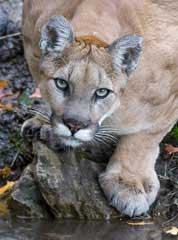Glacier National Park, California, Arizona, Grand Canyon, Colorado
Mountain lion behavior around people tends to be avoidance. These mammals do not want to be seen or noticed, but have probably observed you whenever you hike through their habitat.
Even amongst each other, mountain lions tend to be wary. They live solitary lives and the only time they are not alone is when a mother mountain lion is rearing her cubs.
Mountain lion cubs are both deaf and blind at birth, making them incredibly vulnerable to prey. As a result, mother mountain lions are very protective of their cubs.
While encountering a mountain lion is rare, and a mountain lion attack is even rarer, Glacier National Park is mountain lion habitat. Consequently, you should be aware of mountain lion behavior to best stave one off in the event of encounter or attack.
Mountain Lion Behavior Around Humans
Seeing or hearing a wild mountain lion is rare. Mountain lion sounds, which are typically a “screech” or “scaw”, are often mistaken for other predators, usually owls or eagles. Mountain lion cubs will call to their mother in sounds similar to a high pitched yelp.
Interestingly, a study was performed in the 1970s by the California Department of Fish and Game, which found that mountain lions hung out in high human activity areas, such as wilderness and frontcountry campgrounds.
However, nobody reported seeing these mountain lions. Therefore, it clearly indicates that while mountain lions will cohabitate wilderness areas with humans, they behave in shy, curious ways to avoid being seen or heard.
Mountain Lion Attack Behavior
If you see a mountain lion on the trail, it is probably well aware of your presence. If a mountain lion were to attack, you would not be aware of it until it was on your back. Still, there are reported cases of mountain lions attacking after a human has already seen it.
Learn the difference between curious and aggressive mountain lion actions:
 |
|
Wild mountain lion photo |
Aggressive Mountain Lion Behavior, which may indicate a potential mountain lion attack, includes:
- Stalking
- Closer than 50 yards away
- Hiding
- Creeping
- Crouching
Curious Mountain Lion Behavior is:
- Distance of 50 yards away or greater
- Following, but not trying to hide
- Frequently changes position, but never to a crouching position
- Simple observation
A mountain lion displaying curious behavior is still a threat to young children. If you are hiking through mountain lion habitat and encounter a mountain lion, you must bring young children and pets in close.
It is not unheard of for a mountain lion to attack children after displaying only curious behavior.
How to React to Aggressive Mountain Lion Behavior
If you encounter an aggressive mountain lion, there are steps you can take to help deter an attack or increase your chances of survival during a mountain lion attack.
- Find a weapon – Grab a rock or stick, take out a knife — anything that you can use to defend yourself in the event of an attack
- Stand your ground – Running triggers a predatory response in the mountain lion and it will attack you
- Maintain eye contact – It shows you are knowledgeable of its presence and willing to challenge the mountain lion’s aggression
- Make yourself larger – Pick your jacket over your head, wave your arms, group together with other members of your party
If a mountain lion does attack you, fight back. Use anything at your disposal and go for its neck. Stab, smash, punch–whatever you do, do not lay still and fake death.
More Montana Fish & Wildlife Information
Montana Fish & Wildlife – Return back to information on Montana Fish and Wildlife
Go home from
Mountain Lion Behavior to Glacier National Park Travel Guide











Useful information. Fortunate me I found your web site by accident, and I am stunned why this accident didn’t
happened earlier! I bookmarked it.